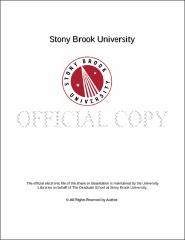| dc.identifier.uri | http://hdl.handle.net/11401/76291 | |
| dc.description.sponsorship | This work is sponsored by the Stony Brook University Graduate School in compliance with the requirements for completion of degree. | en_US |
| dc.format | Monograph | |
| dc.format.medium | Electronic Resource | en_US |
| dc.language.iso | en_US | |
| dc.publisher | The Graduate School, Stony Brook University: Stony Brook, NY. | |
| dc.type | Dissertation | |
| dcterms.abstract | Piezoelectric materials, with their unique electromechanical coupling characteristics, have found widespread use in many applications as sensors and actuators. With a continuing demand for macroscale piezoelectric devices with better performance characteristics, numerous efforts have been made to synthesize " bulk" monolithic and composite piezoelectric materials with better properties. More recently, within the context of microscale devices such as smart MEMS, self-powered sensors, microbatteries, and energy harvesting devices, there is a growing interest in developing " thin-film" piezoelectric materials. While, advances in microfabrication technology have greatly helped the synthesis and fabrication of piezoelectric thin films and structures, there is a continuing need to develop small-scale test methods to characterize the properties of such thin film piezoelectric materials. While nano-indentation-based methods of property determination have been demonstrated to provide useful information about the mechanical properties - elastic, plastic, hardness, and fracture properties, of metallic materials in the thin film form, comprehensive efforts to develop the nanoindentation (or indentation) technique for understanding the electromechanical properties of thin-film piezoelectric materials are not available. The objectives of the present work are: (i) to obtain a comprehensive understanding of the indentation response of several classes of anisotropic piezoelectric materials; (ii) to elucidate the role of the indenter geometry and the indenter conductivity on the effective indentation response of anisotropic piezoelectric materials; (iii) to characterize the effects of electric fields on the indentation response of piezoelectric materials; (iv) to compare the indentation response of piezoelectric thin films with that of piezoelectric islands; (v) to differentiate between materials that are piezoelectrically active or passive, that is, poled and unpoled, and those that are piezoelectrically strong and weak; and (vi) to identify the principal poling directions in active materials. Three-dimensional finite element models are developed to accurately capture the force-depth and charge-depth nanoindentation response of several classes of anisotropic piezoelectric materials such as relaxor ferroelectrics for which analytical models are at present unavailable. Upon validating the finite element model for transversely isotropic materials and with experimental results, it is demonstrated that the nanoindentation response of anisotropic piezoelectric materials displays a strong dependence on the nature of the indenter geometry and relatively weak dependence on the indenter conductivity. Furthermore, by recourse to " longitudinal" and " transverse" indentations, the nanoindentation method can also be used to identify the poling directions in piezoelectric materials as well. It is also demonstrated that the indentation of piezoelectric materials which are subjected to electric fields can be used to uniquely identify the piezoelectric characteristics of thin films that exhibit in-plane poling as well. | |
| dcterms.available | 2017-09-20T16:49:57Z | |
| dcterms.contributor | Venkatesh, T.A. | en_US |
| dcterms.contributor | Koga, Tadanori | en_US |
| dcterms.contributor | Meng, Yizhi | en_US |
| dcterms.contributor | Alkhader, Maen. | en_US |
| dcterms.creator | Cheng, Guang | |
| dcterms.dateAccepted | 2017-09-20T16:49:57Z | |
| dcterms.dateSubmitted | 2017-09-20T16:49:57Z | |
| dcterms.description | Department of Materials Science and Engineering. | en_US |
| dcterms.extent | 99 pg. | en_US |
| dcterms.format | Application/PDF | en_US |
| dcterms.format | Monograph | |
| dcterms.identifier | http://hdl.handle.net/11401/76291 | |
| dcterms.issued | 2013-12-01 | |
| dcterms.language | en_US | |
| dcterms.provenance | Made available in DSpace on 2017-09-20T16:49:57Z (GMT). No. of bitstreams: 1
Cheng_grad.sunysb_0771E_11380.pdf: 8264940 bytes, checksum: 32b2a8cf3d3f1c308f57e527e41b1a98 (MD5)
Previous issue date: 1 | en |
| dcterms.publisher | The Graduate School, Stony Brook University: Stony Brook, NY. | |
| dcterms.subject | Energy harvesting, Finite element method, Nanoindentation, Piezoelectric materials, Thin film | |
| dcterms.subject | Materials Science | |
| dcterms.title | Nanoindentation of Piezoelectric Materials | |
| dcterms.type | Dissertation | |

